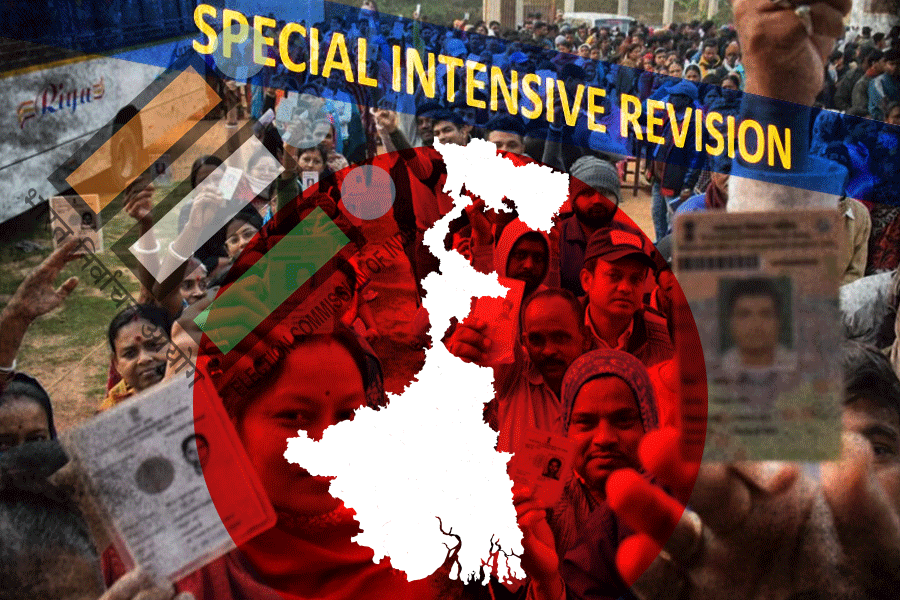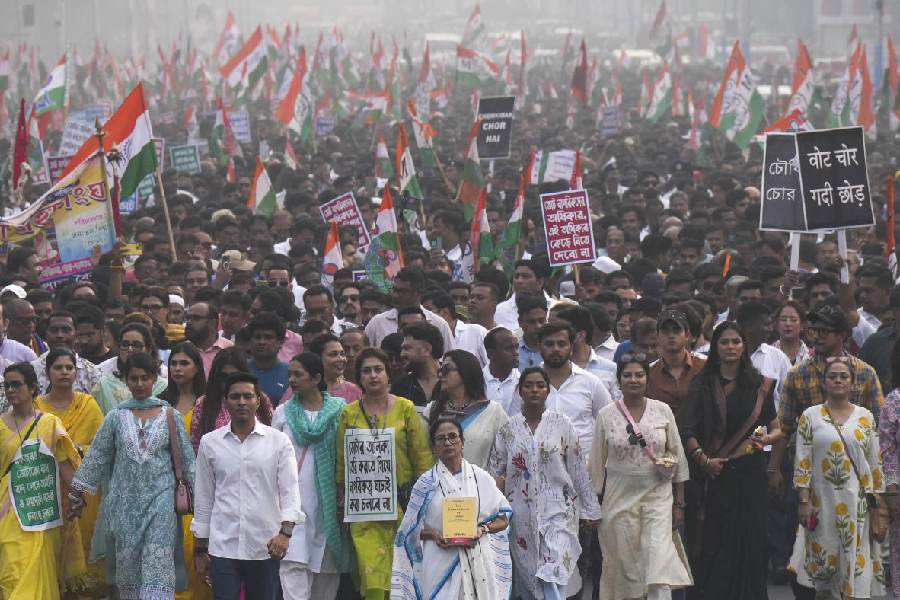
The packing was professional, the bottle elegant, the scent attractive. The eau de toilette cost the equivalent of Rs 85 in one of those 'pound shops' dotted about the homelier parts of London where everything is £1. I bought one for myself and was about to take back a dozen more as presents when I remembered an eight-year-old boy I had complimented on looking nice. "This is only Indian, Uncle!" he said of his shirt. So was the eau de toilette. Many Indians would turn up their noses at it.
However, an Indian product competing with others on a London shop shelf does indicate boundless possibilities for our manufacturers. A report in the international edition of The New York Times on the eve of two marketing jamborees of the Western world - Black Friday and Cyber Monday - about Amazon signing on 27,000 Indian sellers and selling 17 million Indian products, is reminiscent of Peter Drucker's borderless world of European and American technology and marketing promoting African tribal skills. But India's exports lag far behind its potential. So does Indian tourism. Tiny Singapore, with an enviable lifestyle but no attractions save what it has created, draws 16.5 million tourists every year. Only 8.9 million foreign visitors sample the vastness of India with every beauty nature can provide and a dazzling array of man's artefacts.
Sometimes it's perception; sometimes it's reality, often a combination of the two. When a Chinese Singaporean girl recovering from an unhappy love affair in Raffles Place Ragtime, a racy novel by the Ceylon Tamil Singaporean lawyer, Philip Jeyaretnam, says she might travel around India, her friend, also ethnic Chinese, intervenes, "So dirty. You'll catch hepatitis." Reality can also be daunting. A middle-class Englishwoman cruising the Danube last month exploded excitedly when India was mentioned. No other country, she maintained, demanded as many forms, photographs and visits before condescending to issue a tourist visa. Her tale reminded me of Sandhurst-trained Gawain Douglas, proud of serving in General J.N. Chaudhuri's cavalry regiment, and ADC to the governor of Madras in the nineteen-thirties, who joined Mackinnon Mackenzie at Independence because he could not bear to leave India. Douglas was in his nineties when the urge to see India once again gripped him. He took the train from Lewes near Brighton where he lived, travelled 57 miles to London, and presented himself at India House. He was told to come back another day. He did that, collected a form, filled it in and returned to India House. The fault may have been his or of the visa clerk's but it was the wrong form. "I'll go next year" Gawain said, but died before his last ambition could be fulfilled.
Of course, the British visa system is even more tortuous. But they know they can get away with it. They know that if "there'll always be an England", as Vera Lynn sang, there'll always be visitors to England. Hence the prejudice, hauteur and sharp eye on the till. The visa is Britain's most potent instrument of commercial and political diplomacy. Indian chagrin at the travel concessions granted to China confirms how cannily Britain plays the global market. It's rumoured that Theresa May kept close watch on immigration officials during her six years as home secretary, and ensures even now that they are not too welcoming to visitors. Since European Union travellers come and go as they please, this means mainly Afro-Asians. India doesn't enjoy any such advantage. Travellers who brave the visa hurdle then suffer noise, congestion, pollution, squalor and petty exploitation unless they buy escape through costly privacy at the differential rates that some see as a device to soak the rich.
Trade, too, suffers from built-in disadvantages. The 2016-17 Economic Survey calculated that exports need to grow at 26.5 per cent annually for next five years before India can rise above the 1.7 per cent share of the global market at which it has languished since 2011, and claim a respectable 5 per cent of world trade. That bottle of eau de toilette in a Hammersmith pound shop showed India can do it, as did Omar Khayyam sparkling wine some years ago. I first came across it in an Oddbins store and that was further proof of Nani Palkhivala's famous saying that freed from stultifying domestic restrictions, the Indian abroad can buy from a Scotsman, sell to a Jew and still make a profit. When Oddbins's India-born founder, Ahmed Pochee, died in 1999, his obituary in The Guardian called him "the unsung pioneer of the revolution which has transformed wine drinking in Britain over the past quarter of a century." The barely known Pochee, who also founded the Great Wapping Wine Company, Britain's first wine warehouse, "demystified and democratised wine, transforming what had been a daunting ritual for anyone not already an expert into fun at an affordable price."
Karan, Baron Bilimoria, and Kartar Singh Lalvani also live up to Palkhivala's definition. Bilimoria makes "the impossibly smooth" (to cite the ads) Cobra beer. As for Lalvani's Vitabiotics, a vitamin and mineral-based food supplements company, I have yet to discover what it doesn't make. A similar company based in India would not only have to attain the demonstrably world class that Vitabiotics products obviously enjoy but also focus on sophisticated packaging and marketing and ensure continuity of supplies. Omar Khayyam, for instance, disappeared from both Oddbins before the store closed down (to reopen later under a new management) and Budgens, the 145-year-old downmarket supermarket that also sold it.
It's encouraging that exports grew 4.7 per cent in 2016-17 after two years of decline. The various fiscal measures and schemes Nirmala Sitharaman outlined might help further growth. But this is not really something for the government or for the tax-dodging foundations. It's for genuine private industry which needs a congenial climate and honesty of purpose. Pampering a few favourites or mingling devotion with commerce doesn't improve productivity or exports. It would be more to the point to examine the role of incentives, take a long hard look at export promotion schemes, and scrutinize the system of third-party advertising and marketing. Learning from the failure of the first generation of export promotion zones India launched before China, it is necessary to close the gap between the domestic and world markets by basing the export thrust on diversification to meet demand abroad instead of expecting demand to mop up what we supply.
A cheap domestic market right at hand which doesn't bother much with quality and not at all with packaging makes Indian manufacturers careless. Australians complained of infected bandages. Singapore admitted some Indian drugs only after repackaging in Malaysia. Buyers of engineering goods speak of poor after-sales service and difficulties in obtaining spares. The rush to buy even export rejects confirmed the mental identification between Indian and shoddy that Indira Gandhi's stories about Indians abroad buying linen that turned out to be pure desi and "Made in USA" standing for "Made in Ulhasnagar Sindhi Association" highlighted. Although Prince Philip pleaded he had "just got (his) cowboys and Indians mixed up", he may well have meant it when he said while touring a Scottish factory in 1999 that a fuse box was so crude it "looked as though it had been put in by an Indian".
Ironically, a nation whose Mughal emperors designed like giants and finished like jewellers shouldn't have to try too hard to do infinitely better. But as official expectations and standards fell over the years, so did Indian craftsmanship and performance. Our ramshackle railway bogies offer a prime example of the shoddiness that is thought good enough for the multitude. It's hardly a sound foundation for excellence abroad. Exports won't boom until the eau de toilette sold here is not only as good as the one sold in London but Indians also recognize it as such.










